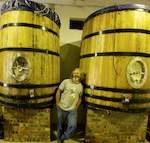'This is not our style,' professes burly Adi Badenhorst, mutton chop sideburns now grew into a bushy beard. Adi Badenhorst's tilted back precariously on a white leatherette dining room chair, boots up on the painted white wooden table. Adi's hands behind his head, wraparound dark glasses resting on shaggy greying auburn hair despite the dark, stormy day on Kalmoesfontein.
Vintage 14

The busy, bohemian interior of the 'dodgy' 1960s farmhouse he's alluding to might be described as shabby chic or retro, Boere Baroque or Voortrekker Zen... whatever. The point is both Adi and wife Cornelia (daughter of legendary Cape winegrower and vintner Jan 'Boland' Coetzee) prefer not to be pigeonholed. Their lifestyle, like Adi's winemaking and sometimes blunt outspokenness, reflects an aversion to social conformity and the pretension and hype often associated with the world of wine.
Adi Badenhorst does not speak easily about himself or his wines (except when blogging or tweeting). This individualist likes to keep people guessing: it's what intrigues them sufficiently to seek out AA Badenhorst Family Wines. That and what's in the glass.
Ultimately, it's the latter that's most important to André Adriaan Badenhorst. And, as winemaking is and always has been as normal a part of his life as eating, sleeping and breathing, his simple premise is to, as a wine farmer, produce a product of the land for consumption. As he was quoted in a 2010 TIME magazine travel piece on 'discovering South Africa’s Winelands': 'We grow grapes, we pick them, we stomp them, we get wine.'
What occupies Adi is authenticity, which is why he's been doing what he does so well in the Swartland: more specifically in the rugged, rocky Siebritskloof on the back end of the Paardeberg. This small mountain separates traditional winegrowing area Paarl from the hinterland's wide expanses of wheat fields interspersed with pockets of vines.
Some are new and have been established with fresh insight into the potential of the area for the right kind of variety. But many are old treasures. Like Adi's 20-odd hectares of vines on Kalmoesfontein: Chenin blanc averaging 40 years; Cinsaut over 45 years; grenache close on 60 years. There's also Chardonnay and Colombard.
It's these vines that Adi Badenhorst, like fellow members of a small band of oft-designated 'revolutionary' young winemakers in the Swartland, is nurturing and extending to produce wines signalling a 'new' South African style, albeit using traditional winemaking methods.
They are independent producers subscribing to the tenets of an unofficial 'manifesto': to explore the area for 'low-yielding, terroir-appropriate, often bush vine, mainly dry land, largely unfashionable old vineyards with limited commercial viability to mainstream producers'. Members of what is now known as the Swartland Independent Producers - by 2012 there were 14 - are described as 'young, strong-minded, passionate and creative' winemakers making 'terroir-expressive, manipulation-free, non-intrusively oaked' wines.
The 'Swartland Revolution' was ignited by Eben Sadie when he went solo with his Sadie Family Wines in 1999/2000, inspired by his experience with the Spice Route venture pioneered by Fairview's Charles Back in the 1990s. Other intrepid young winemakers followed on their family farms or with their own, small and simple startup cellars. As did experienced but similarly experimental vintner [and Guild member] Marc Kent of Boekenhoutskloof (involved through ownership of Porseleinberg).
Through socio-political influences in its colonial history, the Cape has historically adopted the German and French wine cultures in variety and wine style. Yet geographically its southern latitude is more closely mirrored in the northern hemisphere by more southerly wine-growing regions such as Portugal, Spain, and Italy, and perhaps the south of France.
 Swartland eggs benedict with sweet potato rösti with fresh asparagus recipe by Adi Badenhorst paired with AA Badenhorst Family Wines White....
Swartland eggs benedict with sweet potato rösti with fresh asparagus recipe by Adi Badenhorst paired with AA Badenhorst Family Wines White.... Sweet wine jelly with greek yogurt and stewed rhubarb recipe by Adi Badenhorst....
Sweet wine jelly with greek yogurt and stewed rhubarb recipe by Adi Badenhorst....